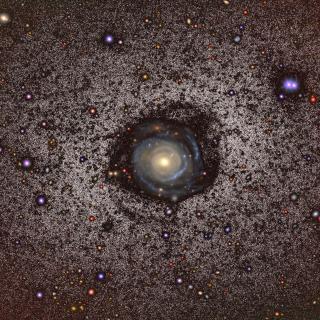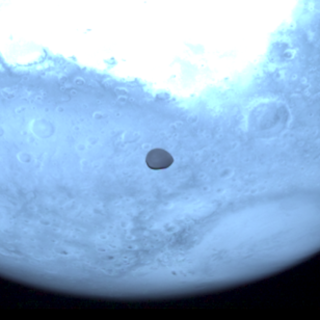The journal Nature will publish these results next Thursday, 10 May
AVAILABLE IN BETACAM 3D ANIMATED SEQUENCES AND INTERVIEWS WITH THE INVESTIGATORS (TEL.: 34 922 605 206 AND 34 922 605 371)
Another interesting link:
http://www.eso.org/outreach/press-rel/
Over the last six years it has been discovered that at least sixty stars have giant planets in orbit around them. Some of these stars even have more than one planet; in many cases, the planets are even closer to their central star than Mercury is to the Sun. The formation of these planets in such close orbits cannot be explained by present theories concerning planetary systems, which predict that the giant planets are born at distances much greater than is observed for exoplanets. As a consequence of phenomena not yet properly explained, such planets are able to migrate from these positions to more distant orbits.
Garik Israelian and Professor Rafael Rebolo of the Instituto de Astrofisica de Canarias (IAC), in collaboration with Nuno Santos y Michel Mayor of Geneva Observatory (Switzerland), will announce the detection of a high content of the isotope lithium-6 in HD 82943 in Nature next Thursday, 10 May. HD 82943 is a solar-type star in the constellation Hydra around which a planetary system consisting of at least two planets similar to Jupiter has recently been discovered.
The lithium-6 isotope does not exist in stars with a chemical composition and age similar to the Sun's, since the quantity of this isotope with which a star initially forms is rapidly destroyed in nuclear reactions in the star's interior during its first evolutionary stages. However, lithium-6 isotope is preserved in giant planets and low-mass brown dwarfs, whose interiors do not reach a sufficiently high temperature for the onset of these reactions.
'At the IAC,' explains Rafael Rebolo, 'we have been investigating the properties of these isotopes for years and they have turned out to be very useful for distinguishing and characterising brown dwarfs. In this new study, the lithium isotopes are used for the first time to investigate the possible phenomena of planetary migration.'
The proportion of lithium-6 (with three protons and three neutrons in the atomic nucleus) found with respect to lithium-7 (with three protons and four neutrons in the nucleus) - similar to the lithium content of meteorites in our Solar System - suggests that the element detected in the star most probably comes from one or more planets that could have fallen into the star as a consequence of gravitational interactions with another planet within the system or with protoplanetary matter. From the quantity of lithium isotopes measured, the scientists have been able to establish approximately the characteristics of the planet that plunged into the star. It could have been a gaseous planet with 2 or 3 times the mass of Jupiter and a similar chemical composition; alternatively, it could have been an Earth-type planet that had a chemical composition similar tot he meteorites of our Solar System.
'This is the first time,' emphasises Rebolo, 'that such direct evidence has been found of such a phenomenon, although for some year now there has been talk of some extrasolar planetary systems appearing to have planets in orbits that must be unstable, which could lead to either the infall or expulsion of planets.'
'The infall of a planet - or maybe of more than one (although we cannot say for sure at the moment) - towards this star HD 82943 in the past must have been an impressive event. To get an idea, imagine Comet Shoemaker-Levy 9 impacting on Jupiter and multiplying the energy involved by a factor of at least a hundred billion,' Garik Israelian explains.
The observations were carried out with one of the new 8m telescopes of the VLT at the European Southern Observatory, in Paranal (Chile), since the star is best observed from the southern hemisphere. Until now, the lithium-6 isotope has not been reliably detected in any star with Sun-like chemical composition or characteristics. The investigators discount any other possible explanation of the phenomenon observed, such as the star itself having produced the observed chemical composition. Israelian concludes, 'In the future we would like to study the chemical composition of other stars with planets and work towards building a general theory that would enable us to understand better the formation and evolution of any planetary system, including ours.'
Title of article: "Evidence for planet engulfment by the star HD82943", por G. Israelian, N.C. Santos, M. Mayor and R. Rebolo.


